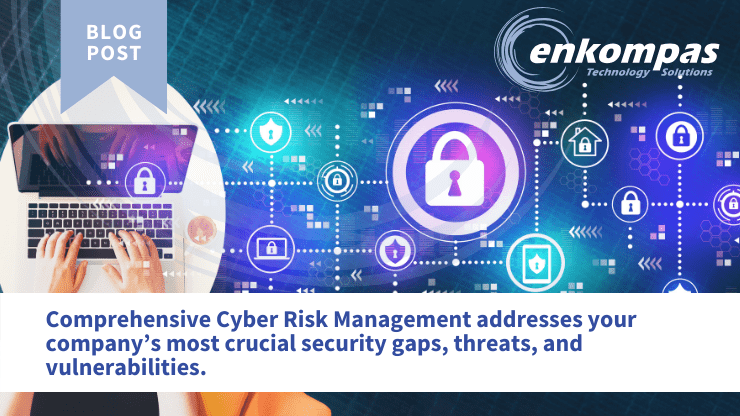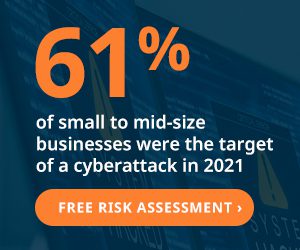What's Cyber Risk Management
As cyber defenses evolve to meet cyberthreats and vulnerabilities, so do the digital forces that disrupt, sabotage, and steal for their personal gain. It’s impossible to eliminate cyber risks, so every business needs a strategy to strengthen their defenses and minimize risk. Comprehensive cyber risk management addresses your company’s most crucial security gaps, threats, and vulnerabilities.
Unlike traditional approaches to cyber security, which are typically focused on technical controls and defenses, cyber risk management is a holistic and integrated approach aimed at identifying, assessing, and mitigating cybersecurity risks across an organization. Done strategically,this approach to cybersecurity can significantly reduce overall risks and strengthen your cyber defenses.
Key Elements of This Cybersecurity Approach
Cyber risk management deviates significantly from traditional approaches and involves the several key elements. Consider the following aspects of this approach and how the strategy is different from traditional methods. The risk management strategy encompasses several overlapping elements to effectively identify, assess, and mitigate cyber risks. It includes elements such as risk assessments; asset inventory; technical and other controls; policies and procedures; employee awareness and training; and executive support and governance.
These elements work in concert to provide a more secure digital environment by simultaneously being built on a foundation that adopts several key approaches to cyber security. Here are those “big picture” pillars of a sound cyber risk management program.
Cyber Risk Management Is a Comprehensive Approach
What makes cyber risk management so powerful is that it’s not merely another layer of security. It’s a holistic and integrated approach, aimed at building risk identification, assessment, and mitigation into the decision-making process. Thorough risk assessments, vulnerability scans, and threat analyses are conducted to identify weaknesses, vulnerabilities, and potential attack vectors. These steps ensure there are no gaps that may put your operations at risk.
The Approach Goes Beyond Technical Controls
Cyber risk management includes technical controls but takes a broader perspective, incorporating various organizational factors, including the cybersecurity culture, business processes, and data management practices. It recognizes the significance of people, processes, and technology. That is, this approach to cybersecurity acknowledges that a robust security strategy is not solely dependent on technology but also on the people implementing it and the processes that guide its deployment.
This ensures a more encompassing and adaptive security strategy. For example, a cyber risk management strategy includes establishing policy and governance within an organization, as well as awareness and training programs for employees and contractors. People inside your organization can be one of your bigger cyber threats if they don’t understand or comply with security protocols.
It's a Strategy that Aligns with Business Objectives
A distinctive feature of the risk management approach is its alignment with your overarching business objectives. It ensures that your cybersecurity strategy considers your mission, goals, and critical assets – thereby making it more relevant to your organization’s success.
This alignment enables digital transformation. As your business adopts new technologies, cloud services, and digital initiatives, cyber risk management becomes crucial for managing the associated risks. Further, it’s essential to ensure the secure implementation and operation of these transformative projects, enabling your organization to achieve its objectives.
It Requires Risk-Based Decision-Making, Prioritization, and Treatment
In traditional cybersecurity, technical measures are frequently deployed without clear connections to specific risks with known probabilities. Cyber risk management, however, adopts a risk-based approach. It involves a deep analysis of potential threats, their impact and likelihood, allowing you to focus technology solutions on addressing the highest-priority risks. It connects the dots between the potential threats out there and the solutions needed to thwart them.
Once risks are identified and assessed, they should be prioritized based on their potential impact and likelihood of occurrence. This allows your organization to focus resources on mitigating the most significant risks first. Risk treatment strategies may include implementing security controls, updating software and systems, adopting best practices, or transferring risks through cybersecurity insurance.
Cyber Risk Management Allocates Resources Based upon Risk Assessment
By prioritizing risks based on their potential impact and likelihood, cyber risk management allows you to allocate resources more effectively. This means that your organization can focus on the areas of cybersecurity that matter the most, optimizing resource utilization. Resources aren’t wasted where both the likelihood of a threat and the stakes are low.
For example, vulnerability scanning detects vulnerabilities in a company’s technology infrastructure, including systems, software, and applications. Once any vulnerabilities are identified, the company can then evaluate the risks associated with each and prioritize remediation efforts and resource allocation accordingly.
The Approach Continuously Monitors and Responds to Incidents
Cyber risks are dynamic, and threats constantly evolve. Therefore, comprehensive risk management requires continuous monitoring of your organization’s cybersecurity posture, threat intelligence gathering, and an effective incident response plan to quickly detect, respond to, and recover from cyber incidents.
Continuous monitoring and responding involves implementing appropriate security controls and countermeasures. This includes technical controls (e.g., firewalls, intrusion detection/prevention systems, encryption), administrative controls (e.g., security awareness training, incident response plans), and physical controls (e.g., access control measures, environmental safeguards).
It's Periodically Reviewed and Improved
Cyber risk management is an ongoing process that requires routine review and improvement, based upon changing needs and threats. Organizations like yours must regularly evaluate the effectiveness of risk management strategies, update policies and controls to align with evolving threats and best practices, and continuously enhance their cybersecurity posture.
The digital world runs at a breakneck speed with cyberattacks are accelerating correspondingly. On average, a cyberattack occurs every 39 seconds, over 300,000 piece of malware are created every day, and more than 30,000 websites are hacked daily. The digital world is scary! Every company must audit its efforts regularly, assess any new risks, and seek ways to improve your efforts.
Time to Launch Your Cyber Risk Management Strategy
Now that you understand how cyber risk management offers a more holistic, strategic, and proactive approach to cybersecurity than traditional methods, it’s time to take action to strengthen your defenses.
By adopting the comprehensive and multi-layered approach of cyber risk management, your organization can effectively identify, assess, and mitigate cyber risks, protecting your assets, customers, and reputation, ensuring business continuity in the ever-changing digital landscape.
Don’t wait for the next cyberthreat to strike, get started today to enhance your digital defenses and secure your organization’s future by prioritizing your security.
About enkompas Technology Solutions
enkompas powers your entire technology environment, working closely with your team to provide strategic enterprise technology solutions. With nearly 30 years of experience as a trusted Managed IT Services Provider, our goal is to help you build a secure, scalable organizational roadmap for your IT environment. Contact us for more information about how we partner with clients to enhance their business outcomes, fill IT gaps, lower costs, while protecting them from ever-increasing, sophisticated cyberthreats


